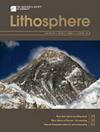Characteristics of In Situ Desorption Gas and their Relations to Shale Components: A Case Study of the Wufeng-Longmaxi Shales in Eastern Sichuan Basin, China
IF 1.7
4区 地球科学
Q3 GEOCHEMISTRY & GEOPHYSICS
引用次数: 2
Abstract
In situ desorption gas measurement can be used to evaluate shale gas potential, sweet spot prediction, and production strategy optimization. However, gas contents and carbon isotope compositions of in situ desorption gas and the relationship to reservoir properties and shale compositions are not systematically studied from the actual production situation. In this study, 63 core shales of Wufeng-Longmaxi formation from the YY1 well in the eastern Sichuan Basin were subjected to TOC (total organic carbon), solid bitumen reflectance (Rb), maceral fractions of kerogen analysis, and X-ray diffraction (XRD) analysis to obtain shale compositions, and 10 selected samples were conducted on low-pressure N2/CO2 (N2/CO2GA), mercury injection capillary pressure (MICP), and field emission scanning electron microscopy (FE-SEM) tests to acquire reservoir properties. Meanwhile, 60 samples were also subjected to in situ desorption tests to obtain shale gas content, and 5 selected samples were used to investigate variations in shale gas compositions and carbon isotopes during the desorption process. Results indicated that transient rates of shale gas during desorption process are significantly controlled by desorption time and temperature. In terms of in situ desorption process, total gas is divided into desorbed gas and lost gas. Desorbed gas is mainly comprised of CH4, N2, CO2, and C2H6, with desorption priorities of N2 > CH4 > CO2 ≈ C2H6, which are consistent with their adsorption capacities. The δ13CH4 values tend to become heavier during desorption process, varying from -37.7‰ to -16.5‰, with a maximum increase amplitude of 18.8‰, whereas the change of δ13C2H6 value, from -38.2‰ to -34.8‰, is minor. Desorbed gas shows carbon isotope reversals, due to that preferential desorption of 12C-CH4 during desorption process results in δ13C value less negative in CH4. The tested desorbed gas, lost gas, and total gas ranged 0.088 to 1.63 cm3/g, 0.15 to 3.64 cm3/g, and 0.23 to 5.20 cm3/g, respectively. Shale gas content, i.e., desorbed gas and lost gas, is controlled primarily by TOC content and organic matter (OM)-hosted nanometer-size pores. Clay mineral content is negatively correlated with shale gas content, due to that, clay mineral pores are more easily compacted during burial and occupied by water molecules. Compared with shale gas reservoirs in North America, the studied shale reservoir has high brittle mineral content and permeability, which is considered to have great potential of shale gas resource and to be the next commercial development zone in south China.原位解吸气特征及其与页岩组分的关系——以川东地区五峰组—龙马溪组页岩为例
现场解吸气测量可用于评估页岩气潜力、甜点预测和生产策略优化。然而,从实际生产情况出发,对原位解吸气的含气量、碳同位素组成及其与储层物性、页岩成分的关系尚未进行系统研究。本研究对川东地区YY1井五峰组—龙马溪组63组岩心页岩进行了总有机碳(TOC)、固体沥青反射率(Rb)、干酪根显微组分分析和x射线衍射(XRD)分析,获得了页岩组分,并选取10个样品进行了低压N2/CO2 (N2/CO2GA)、注汞毛细管压力(MICP)、以及场发射扫描电镜(FE-SEM)测试来获取储层性质。同时,对60份样品进行了原位解吸试验,获得了页岩气含量,并选取了5份样品,研究了解吸过程中页岩气成分和碳同位素的变化。结果表明,页岩气在解吸过程中的瞬态速率受解吸时间和温度的显著控制。在原位脱附过程中,总气分为脱附气和损失气。解吸气体主要由CH4、N2、CO2和C2H6组成,解吸优先级为N2 > CH4 > CO2≈C2H6,这与它们的吸附能力一致。δ13CH4值在解吸过程中有变重的趋势,变化范围为-37.7‰~ -16.5‰,最大增幅为18.8‰,而δ13C2H6值变化幅度较小,变化范围为-38.2‰~ -34.8‰。解吸气表现出碳同位素倒转,这是由于解吸过程中12C-CH4优先解吸,导致CH4 δ13C值负较小。测试的解吸气、损失气和总气分别为0.088 ~ 1.63 cm3/g、0.15 ~ 3.64 cm3/g和0.23 ~ 5.20 cm3/g。页岩气的含量,即解吸气和损失气,主要受TOC含量和有机质(OM)纳米孔隙的控制。黏土矿物含量与页岩气含量呈负相关,因此在埋藏过程中,黏土矿物孔隙更容易被水分子压实并占据。与北美页岩气储层相比,研究区页岩气储层具有较高的脆性矿物含量和渗透率,具有巨大的页岩气资源潜力,是华南地区下一个商业开发区。
本文章由计算机程序翻译,如有差异,请以英文原文为准。
求助全文
约1分钟内获得全文
求助全文
来源期刊

Lithosphere
GEOCHEMISTRY & GEOPHYSICS-GEOLOGY
CiteScore
3.80
自引率
16.70%
发文量
284
审稿时长
>12 weeks
期刊介绍:
The open access journal will have an expanded scope covering research in all areas of earth, planetary, and environmental sciences, providing a unique publishing choice for authors in the geoscience community.
 求助内容:
求助内容: 应助结果提醒方式:
应助结果提醒方式:


